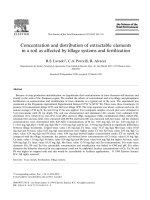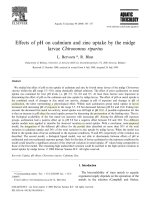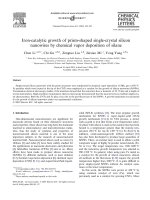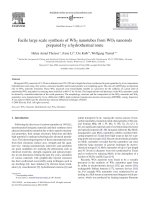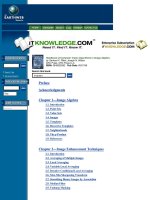Design of Offshore Concrete Structures _ ch01
Bạn đang xem bản rút gọn của tài liệu. Xem và tải ngay bản đầy đủ của tài liệu tại đây (1.52 MB, 16 trang )
1 State of the art
Ivar Holand, SINTEF
1.1 Historical overview
The beginning of the story of the remarkable offshore concrete structures is only 30 years behind
us. When the petroleum industry established activities in the North Sea in the late sixties, an
immediate reaction from the Norwegian construction industry was that concrete should be able
to compete with steel, that had been the traditional structural material in this industry (Fjeld and
Morley, 1983), (Moksnes, 1990), (Gudmestad, Warland, and Stead, 1993). This assumption
proved to be true regarding the cost of the structure as well as the maintenance costs.
One after the other of spectacular structures, 22 in total, have been placed on the sea bed in
the North Sea reaching up to 30 m above sea level and down to 303 m at the deepest location,
making this structure one of the tallest concrete structures in the world (Holand and Lenschow,
1996). (A general description of an offshore concrete structure is also found in Chapter 2.)
The most innovative period was around 1970, when the Ekofisk concrete platform was towed
to its location (Fig. 1.1), and the first of the many Condeep platforms was on the drawing board.
Fig. 1.1 The Ekofisk tank, completed 1973 (by courtesy of Aker Maritime)
© 2000 Edited by Ivar Holand, Ove T. Gudmestad and Erik Jersin
Offshore concrete structures have proved to represent a competitive alternative for
substructures in the North Sea and in other places where large offshore structures for production
of oil and/or gas are required. The deep Norwegian fjords have represented a particular
advantage during the construction phase, as the substructures here can be lowered deep into the
sea, enabling the production plant to be floated on barges over the platform for transfer to the
substructure. Hence, the production plant can be completed at quay side where the productivity
is best. Hereby, costly offshore heavy lifting and hook-up activities are avoided.
Furthermore, offshore concrete structures have proved to be highly durable and to have good
resistance against corrosion (Fjeld and Morely, 1983), provided that the concrete is dense, have
a minimum of cracks and sufficient cover over the rebars. The Norwegian Standard NS 3473
requires 40 mm for permanently submerged parts and 60 mm in the splash zone. In the North
Sea even larger rebar covers have normally been used.
Recent concrete projects are:
• in the Netherlands: F3, concrete gravity base 1992
• in the North Sea, Norwegian sector: Troll gas fixed platform (Fig. 1.2), Heidrun tension leg
platform (Fig. 1.3) and Troll oil catenary anchored floating oil platform (Fig. 1.4), all
completed in 1995
• in the North Sea, British sector: The BP Harding Gravity Base Tank completed in 1995
• in Congo: N’Kossa, concrete barge 1995
• in Australia: Wandoo B, Bream B, West Tuna, concrete substructures completed 1996
• on the Canadian continental shelf outside Newfoundland: Hibernia 1997
• in the North Sea, Danish sector: South Arne, to be completed in 1999.
Although the recent development has not favoured concrete platforms, there are several concept
studies ongoing in the design offices. As promising floater concepts, new generations of tension leg
platforms and a concrete Spar shall be mentioned. (Chabot, 1997), (Brown and Nygaard, 1997).
At present work is ongoing to develop more cost-efficient concrete structures for
development of smaller hydrocarbon fields. The F3 field in the Dutch offshore sector,
mentioned above, is an example; a concrete structure installed at Ravenspurne North in the
British sector is another.
1.2
Design concepts
1.2.1 Cylindrical tanks
The first concrete platform was the Ekofisk platform (Fig. 1.1), that was built according to a
French-Canadian concept and completed in 1973.
The decision to launch the Ekofisk platform made way for the development, not only of
offshore structures but also for a development of the concrete material, design methods,
construction methods, load predictions, quality management and safety evaluations.
Three additional designs in the North Sea followed mainly the Ekofisk concept (Frigg CDP1 1975, Frigg MP-2 1976 and Ninian Centre 1978) (FIP, 1996). The huge platform built by
© 2000 Edited by Ivar Holand, Ove T. Gudmestad and Erik Jersin
Mobil at the Hibernia field in Canadian waters and completed in 1997 is also mainly of the
same type.
1.2.2 Condeeps and similar gravity based structures
The next concept, the Condeep, which became the winning concept for a period of time, was
based on a cellular base with circular cells and one to four hollow columns (shafts), and thus had
the advantage of a slim shape through the wave zone. Beryl Alpha, the first Condeep platform,
was placed on the UK continental shelf in 1975. Up to 1995 a total of 14 Condeeps have been
installed in the North Sea (Ågnes, 1997). Fig. 1.2 shows the largest of these structures.
Other designs were based on the same principles, except that the cells in the raft were
rectangular (four platforms in the North Sea completed 1976–78, and also BP Harding in UK
waters, 1995, and South Arne on Danish Continental shelf, 1999).
1.2.3 Tension leg floaters
As the exploitation of hydrocarbons moved to deeper waters, structures carried by buoyancy
became more competitive than gravity based structures. For the first concrete tension leg
platform, the Heidrun platform (Fig. 1.3) installed in 1995 in 345 m of water, the complete
hull, including the main beams carrying a steel deck, is made of high performance lightweight
aggregate concrete. The structure received the FIP (Fédération Internationale de la
Précontrainte) award for outstanding structures 1998 (FIP 1998).
1.2.4
Catenary anchored floaters
Depending on several factors (depth, wave conditions, etc.) a catenary anchoring may be
preferred. The first concrete platform of this type is shown in Fig. 1.4.
1.2.5
New concepts
Future concrete structures will most probably be based on a variety of new concepts (Ågnes,
1997), (Olsen, 1999), e.g.:
•
•
•
•
Jack-up foundations (ex. BP Harding in the UK sector of the North Sea (O’Flynn, 1997))
Anchorage Foundations for Tension Leg Platforms
Spar buoys
Lifting vessels for removal
A cost comparison of concrete and steel spar buoys (Chabot, 1997) shows an overall saving of
10% in the favour of the concrete option.
© 2000 Edited by Ivar Holand, Ove T. Gudmestad and Erik Jersin
Fig. 1.2 Troll Gas, the largest platform of the CONDEEP type (by
courtesy of Aker Maritime)
•
•
•
•
completed 1995
water depth 303 m
height of concrete structure 369.4 m
concrete volume 234 000 m3
© 2000 Edited by Ivar Holand, Ove T. Gudmestad and Erik Jersin
Fig. 1.3 Heidrun, the first tension leg floater with a concrete hull
(by courtesy of Aker Maritime)
•
•
•
•
completed 1995
hull draft at field 77 m
concrete volume 66 000 m3, LC 60, density 1950 kg/m3
water depth 345 m
© 2000 Edited by Ivar Holand, Ove T. Gudmestad and Erik Jersin
Fig 1.4 Troll Oil, the first catenary anchored floater with a concrete
hull (by courtesy of Kvaerner Concrete Construction)
•
•
•
•
completed 1995
hull draft at field 40 m
concrete volume 43 000 m3
water depth 325 m
© 2000 Edited by Ivar Holand, Ove T. Gudmestad and Erik Jersin
1.3 Development of the concrete material
When the Ekofisk tank (completed 1973) was designed, the highest strength class allowed
according to Norwegian Standard was used, namely B 450 with a cube strength (in present units)
of 45 MPa, now denoted C 45. Economy favoured a continuous increase of concrete strength
grades, in particular because cylindrical and spherical shapes were preferred. These needs
contributed strongly to the development of high strength/high performance concretes. The strength
grades in recent structures are, for comparison, about C 80–85. The increase has been made
possible by a steadily increasing level of knowledge accumulated through experience and research.
(Moksnes and Sandvik, 1996), (Neville and Aïtcin, 1998), (Moksnes and Sandvik, 1998).
•
•
•
•
Important factors contributing to the improvements of concrete qualities are:
development of a high strength cement
well controlled aggregate grading
admixtures, in particular superplasticisers and retarders
strict quality assurance procedures
The mechanical properties of high-strength concrete differ in many ways from those of traditional
concrete. Thus, traditional design procedures for reinforced concrete cannot be extrapolated to
new strength classes without a thorough study and relevant modifications. To avoid unnecessary
restrictions to the application of high-strength concrete, the extended knowledge must be
implemented as rules for high-strength concrete in standards and codes of practice (Section 1.6).
1.4 Design
1.4.1 Preliminary design
Offshore concrete platforms are constructed inshore, floated to a deep-water site for deckmating and towed to their operation positions offshore. This construction procedure implies
that the structures must be hydrodynamically stable under many different conditions.
Moreover, dynamic response is important in temporary stages as well as at the operating stage.
Such requirements necessitate that geometrical external shapes as well as weights and
rigidities (and hence thicknesses) are reasonably well approximated in the preliminary design,
and that the detailed analyses mainly serve to specify ordinary reinforcement and prestressing
steel. In the preliminary design, basic understanding of structural mechanics and traditional
shell theory, and experience from similar structures play an important role, but computer
analyses may be also used in this phase.
1.4.2
Global analysis
The first designs of the Condeep structures were based on simple, classical shell calculations as
© 2000 Edited by Ivar Holand, Ove T. Gudmestad and Erik Jersin
described under preliminary analyses above. However, the intersections between the different
shell elements introduce irregularities, and the wave loads and other loads introduce various
forces in addition to the hydrostatic ones. Such facts call for more advanced methods of analysis.
The structural analyses have mainly been based on a linear theory of elasticity, and since the
mid-seventies on the use of large finite element programs. The largest finite element
calculations may involve more than one million degrees of displacement freedoms and require
the use of supercomputers (such as CRAY YMP/464 that has been used for the largest
analyses) (Brekke, Åldstedt and Grosch, 1994) (Galbraith, Hodgson and Darby, 1993).
1.4.3
Postprocessing. Dimensioning
The offshore platforms are subjected to a large number of loading conditions during the
construction, tow-out, installation, operation and removal phases. Large hydrostatic pressures
dominate during deck-mating, while wave, current and wind loads dominate during the
operation phase. To permit the handling of all relevant load cases, a number of basic load cases
are selected, from which the actual load cases with load factors for the relevant limit state,
possible amplification factors, etc; may be obtained by linear scaling and superposition. To
utilize the huge amount of data from the finite element analysis in an efficient dimensioning of
the reinforced concrete sections of the structure, a post-processor that is specially developed
for the purpose is needed (Brekke, Åldstedt and Grosch, 1994).
The strength of the reinforced concrete is checked point-wise by comparing the stress
resultants with the strength in the same point. The strength evaluation relies on semi-empirical
design formulae, mainly based on reduced scale experiments on beams and column elements,
and is taking into account cracking and other non-linear effects. The design formulae are
specified in codes and standards, but have also been supplemented by special procedures in the
post-processors (Brekke, Åldstedt and Grosch, 1994). Refinement of the methods is still going
on (Gérin and Adebar, 1998).
1.5 Construction methods
Offshore concrete platforms are constructed inshore, and vertical walls have mainly been
constructed by slipforming. Slipforming has also been extended to be used for non vertical
walls, variable thicknesses and variation of diameters and cross section shapes as usually
needed in the shafts. The slipforming method requires a careful control of the concrete
consistency in order to avoid flaws in the concrete surfaces, thus requiring an intimate
interaction between material technology and construction procedure.
When the concrete structure is completed, it is floated to a deep-water site for deck-mating
and towed to the operation position offshore. The production hence also includes challenging
marine operations in narrow fjords.
© 2000 Edited by Ivar Holand, Ove T. Gudmestad and Erik Jersin
1.6 Rules and regulations
1.6.1
Government regulations
Design and construction of offshore structures must, like structures onshore, follow rules that
basically are laid down by the government that has the sovereignty of the area in question, e.g. in:
USA:
United States Department of the Interior
UK:
Department of Energy: Statutory Instruments SI 289 1974 The offshore
installations
Norway: Norwegian Petroleum Directorate Norwegian Petroleum Law with Regulations
and Guidelines (NPD, latest version applies).
For the design work in Norwegian waters the following regulations are of particular relevance:
• Regulations relating to safety, etc. to Act No. 11 of March 22nd 1985, relating to the
petroleum activities
• Regulations relating to loadbearing structures in the petroleum activities including:
*
Guidelines to regulations
*
Guidelines concerning loads and load effects
*
Guidelines relating to concrete structures
• Regulations relating to the licensee’s internal control in the petroleum activities on the
Norwegian continental shelf
• Regulations relating to implementation and use of risk analyses in the petroleum activities,
with Guidelines.
As for structural concrete, Norwegian Petroleum Directorate’s “Regulations relating to load
bearing structures with Guidelines” are mainly based on Norwegian standards; see also
Section 1.6.2 and Chapter 5.
1.6.2
Standards
In many countries, government regulations use the “reference to standards” principle,
implying that requirements to safety of structures is considered to be satisfied if specified
standards are followed. Thus, standards play an important role for offshore structures. Relevant
standards are, for instance:
• Canadian standard CSA S474–94 Concrete Structures. Part IV of the Code for the Design,
Construction, and Installation of Fixed Offshore Structures. ISSN 0317-5669. June 1994.
• ISO standard 13819 Part 3 (to appear, will cover the entire engineering process for offshore
concrete structures). For design, NS 3473 is referred to as a standard that covers relevant
conditions (Leivestad, 1999).
• Norwegian Standard NS 3473 Concrete Structures. Design Rules. 4th edition 1992 (in
English), 5th edition 1998 (English edition in print).
© 2000 Edited by Ivar Holand, Ove T. Gudmestad and Erik Jersin
• Norwegian Council for Building Standardisation (1999), Specification texts for building and
construction, NS 3420, Oslo, Norway, 2nd edition 1986, 3rd edition 1999.
Other documents may play a similar role, e.g. ACI 318–95, saying in the introduction: “The code
has been written in such a form that it may be adopted by reference in a general building code...”
The European prestandard (Eurocode 2, 1991) covers concrete structures in general, but
says explicitly that it does not cover offshore platforms.
Standards are in general not mandatory documents. Similarly, they may also be used outside
the country or region where they were issued. As an example, the Norwegian standard for
concrete structures was used for the concrete platform on the Hibernia field, Newfoundland,
Canada. The reason why the Norwegian standard was preferred was mainly that the operator
(Mobil) was well acquainted with this standard from previous projects in the North Sea.
1.6.3
Certification. Classification companies
Control and approval of offshore installations is regulated by national government authorities.
The third party role of classification societies in this activity differs (Andersen and Collett, 1989).
The most active classification societies in offshore activities are Lloyd’s Register and DNV,
which may be described briefly as follows:
• Lloyd’s Register is the world’s premier ship classification society and a leading independent
technical inspection and advisory organisation, operating from more than 260 exclusively
staffed offices worldwide and served by 3,900 technical and administrative staff.
• Det Norske Veritas (DNV), Oslo is an independent, autonomous foundation established in
1864 with the objective of safeguarding life, property and the environment. DNV has 4,400
employees and 300 offices in 100 countries. DNV establishes rules for the construction of
ships and mobile offshore platforms and carries out in-service inspection of ships and
mobile offshore units.
1.6.4 Company specifications
Codes and standards are often not sufficient as technical contract documents. Thus, oil companies
often choose to issue their own, more detailed, company specifications. Such specifications may
also prescribe safety requirements in addition to those given in rules and regulations. An example
of such a specification is NSD 001, issued by Statoil, a Norwegian oil company.
1.6.5
Development of codes and standards
Codes and standards are subject to a continuous scrutinizing and updating to be abreast of the
technical development. Many actual decisions are, however, taken in a pre-standardization
phase, where the new knowledge is digested in discussions in an international environment.
Important organizations in this role are:
© 2000 Edited by Ivar Holand, Ove T. Gudmestad and Erik Jersin
• fib: International Federation for Structural Concrete (established 1998 by merging FIP and
CEB)
• ACI: American Concrete Institute
• RILEM: International Union of Testing and Research Laboratories for Materials and
Structures.
1.7 Quality assurance
The highly automated analyses by using finite element methods and dimensioning by postprocessors have their pit-falls. Thus, comprehensive schemes for quality assurance are
implemented to avoid errors in analysis and design, including simplified checks of results of
the global analysis, mainly equilibrium checks. A manual issued by the Norwegian oil
company Statoil recommends that the simplified preliminary analyses discussed above are
systemized in such a way as to also serve the purpose of a rough check of the results of the
detailed analyses (Gudmestad, Holand, and Jersin, 1996).
The need for quality assurance procedures is well illustrated by the Sleipner accident. The
gravity base structure of the Sleipner A platform is a traditional Condeep platform placed at a
moderate depth of 82 m in the North Sea. The first concrete hull built for this purpose sprang
a leak and sank under a controlled ballasting operation in Gandsfjorden outside
Stavanger, Norway, on 23 August 1991 (Jakobsen, 1992). It was rebuilt and placed in position
in 1993.
1.8 Durability
The first concrete platform was placed in the North Sea in 1973. Since then the behaviour of
these structures has been investigated thoroughly by means of inspection and instrumentation
programmes. In addition, data from maintenance and repair reports are available. Based on
such data, the durability of offshore concrete structures has been studied by a working group
appointed by FIP (FIP 1996). The conclusions of this group are, directly quoted:
•
•
•
•
the concrete offshore platforms provide full operational safety
they show a very high durability level
they do not require costly maintenance and repair operations
their effective lifespan has been underestimated and their 20 years initial design life can be
greatly protracted
The document has been based on an inquiry answered by:
•
•
•
•
The Norwegian Petroleum Directorate
Oil companies
Certifying authorities
Contractors and consultants
© 2000 Edited by Ivar Holand, Ove T. Gudmestad and Erik Jersin
Similar conclusions are found in (Ågnes, 1997), (Moksnes and Sandvik, 1998), (Bech and
Carlsen, 1999) and (Helland and Bjerkeli, 1999).
The FIP report also contains recommendations for design, construction and inspection practice.
1.9 Competitiveness
In spite of good experience with concrete structures, they will not be competitive for all
offshore projects. A few essential arguments for the choice of a concrete structure, because of
cost efficiency, are listed below (Ågnes, 1997):
•
•
•
•
•
•
•
•
Topside weight. Heavy topsides can be accomodated on a concrete substructure.
Storage. Oil and stable condensate can be stored in concrete cells.
Durability and maintenance. Concrete is favourable when long life-time is desired.
Seabed conditions. On firm soils the concrete platform rests perfectly by its own weight. On
soft soils long skirts provide an efficient solution.
Collision strength. Concrete is robust to local damage.
Motion characteristics of floaters. Concrete platforms offer better characteristics because of
larger displacement.
Ice infested areas. Concrete may be designed to resist ice forces.
Local content. Large parts of the plain construction work can be carried out by unskilled
labour under competent guidance.
Cost competitiveness is also discussed in (Collier, 1997) and (Michel, 1997). Marine concrete
structures for the future are discussed by showing several options by Olsen (Olsen, 1998) and
by Iorns (Iorns, 1999).
1.10
Removal. Demolition. Recycling
It is assumed that all future offshore concrete platforms shall be removed from site after
decommisioning, except, perhaps, in rare cases. The decommisioning will usually start by
refloating of the platform. All concrete platforms need a ballasting system, for ballasting to a
proper draught, during production and tow-out and final positioning on site. In recent cases
(for Condeep platforms since Statfjord B 1978) the ballasting system has also been designed to
be used for refloating. Even Platform Removal Manuals have been produced during the design
phase in some cases. In spite of this, the refloating is no straightforward operation and will
require extensive studies of safety precautions during the operation, including possible
strengthenings. Problems encountered are, for example, related to penetrations by conductors.
A re-use on another site is generally unrealistic, and the next step will therefore be
demolition and preferably reuse of reinforcement steel and crushed concrete (Olsen and
Høyland, 1998) (Høyland and Maslia, 1999). For the monotower platform Draugen and the
floating unit at Heidrun, removal and demolition studies have been performed. Concrete
Platforms for re-use have, however, also been discussed (Stead and Gudmestad, 1993).
© 2000 Edited by Ivar Holand, Ove T. Gudmestad and Erik Jersin
1.11 Spin-off effects
The technology developed for the offshore concrete structures has had a number of spin-off
effects for onshore or near-shore construction technology. The following know-how and
analysis tools for advanced technologies are mentioned, with examples of use for other types
of structures:
Know-how on:
• high performance concrete (sub-merged tunnels, any concrete structures designed for longterm durability)
• high-strength normal-weight concrete (long-span bridges)
• high-strength lightweight aggregate concrete (long-span bridges, floating bridges)
• complex slip-forming with change of thickness and change of cross-section shape (towers,
silos)
• marine operations in open sea (complex marine transfer and tow operations)
• marine operations in coastal waters (floating bridges, submerged tubular bridges)
• underwater soil mechanics (submerged tunnels)
• evaluation of accidental actions (industrial plants).
Software for:
•
•
•
•
finite element analyses (irregular box-shaped bridges)
dynamic analyses of structures (towers, bridges built by cantilevering techniques)
static and dynamic wave force analyses (floating bridges, submerged tubular bridges)
pre-processors and post-processors for structural design (bridges, other complex
structures).
The examples illustrate that the offshore concrete platforms have brought the total concrete
design and construction technology a substantial step forward, a fact that can be utilized also in
related applications of the technology. (Olsen, 1999), (Andrews and Bone, 1998).
References
Ågnes, R. (1997) Concrete for Marine Applications. CONCRETE a feasible option for
offshore construction. Two-day International Conference, IBC Technical Services,
Aberdeen, May 1997.
Andersen, H.W. and Collett, J.P. (1989) Anchor and Balance. Det norske Veritas 1964–1989.
J.W.Cappelens Forlag A.S.Oslo.
Andrews. J. and Bone, D. (1998) The specification of concrete for coastal defence and marine
works. Concrete, April 1998. pp. 24–26.
© 2000 Edited by Ivar Holand, Ove T. Gudmestad and Erik Jersin
Bech, S. and Carlsen, J.E. (1999) Durability of high-strength offshore concrete structures. 5th
International Symposium of High Strength/High Performance Concrete Structures. Eds.
Holand, I. and Sellevold, E.J.Sandefjord, Norway, 1999. pp. 1387–1394.
Brekke, D.-E., Åldstedt, E. and Grosch, H. (1994) Design of Offshore Concrete Structure
Based on Postprocessing of Results from Finite Element Analysis (FEA), Proceedings of
the Fourth International Offshore and Polar Engineering Conference, Osaka, Japan.
Brown, P. and Nygaard, C. (1997) New Generation TLP. CONCRETE a feasible option for
offshore construction. Two-day International Conference, IBC Technical Services,
Aberdeen May 1997.
Chabot, L. (1997) Spar structures—Steel versus concrete. CONCRETE a feasible option for
offshore construction. Two-day International Conference, IBC Technical Services,
Aberdeen May 1997.
Collier, D. (1997) Cost competitive concrete platforms—Innovative solutions for today’s
market. CONCRETE a feasible option for offshore construction. Two-day International
Conference, IBC Technical Services, Aberdeen May 1997.
Eurocode 2 European Prestandard ENV 1992–1–1. (1991): Design of concrete structures.
CEN 1991 (under revision 1999 for transformation to EN, European Standard).
FIP (1996). State of the Art Report—Durability of concrete structures in the North Sea. SETO,
London.
FIP (1998) Awards for Outstanding Structures. XIII FIP Congress 1998, Amsterdam.
Fjeld, S. and Morley, C.T. (1983) Offshore concrete structures in Handbook of Structural
Concrete. Eds. Kong, F.K., Evans, R.H., Cohen, E. and Roll, F., Pitman, London.
Galbraith, D.N., Hodgson, T. and Darby, K. (1993) Beryl Alpha—Condeep GBS Analysis.
SPE 26689. Offshore Europe Conference, Aberdeen September 1993.
Gérin, M. and Adebar, P. (1998) Filtering analysis output improves the design of concrete
structures. Concrete International. December 1998. pp. 21–26.
Gudmestad, O.T., Holand, I. and Jersin, E. (1996) Manual for Design of Offshore Concrete
Structures. Statoil, Stavanger, Norway.
Gudmestad, O.T., Warland, T. Aa. and Stead, B.L. (1993) Concrete Structures for development
of offshore fields. Journal of Petroleum Technology, August 1993. pp. 762–770.
Helland, S. and Bjerkeli L. (1999) Service life of concrete offshore structures. Offshore West
Africa ’99 Conference and Exhibition, Abidjan, Ivory Coast.
© 2000 Edited by Ivar Holand, Ove T. Gudmestad and Erik Jersin
Holand, I. and Lenschow, R. (1996) Research Behind the Success of the Concrete Platforms in
the North Sea. Mete A. Sozen Symposium. ACI SP-162. Farmington Hills, Michigan, pp.
235–272.
Høyland, K. and Maslia, J. (1999) Removal and recycling of high strength offshore concrete
structures. 5th International Symposium on Utilization of High Strength/High Performance
Concrete. Sandefjord, Norway.
Irons, M.E. (1999) Low-Cost Ocean Platform Construction—A Point of view. Concrete
International. December 1999.
Jakobsen, B. (1992) The Loss of the Sleipner A Platform. Proceedings of the Second (1992)
International Offshore and Polar Engineering Conference. San Francisco 1992.
Leivestad, S. (1999) ISO Standard for fixed concrete structures. 5th International Symposium of
High Strength/High Performance Concrete Structures. Edited by Holand, I and Sellevold,
E.J., Sandefjord, Norway, 1999. pp. 421–426.
Michel, D. (1997) The advantages of floating concrete construction. CONCRETE a feasible
option for offshore construction. Two-day International Conference, IBC Technical
Services, Aberdeen May 1997.
Moksnes, J. (1990): Oil and Gas Concrete Platforms in the North Sea—Reflections on two
Decades of Experience. Durability of Concrete in Marine Environment, An International
Symposium Honoring Professor Ben C.Gerwick, Jr., University of California.
Moksnes, J. and Sandvik, M. (1996) Offshore concrete structure in the North Sea. A review of
25 years continuous development and practice in concrete technology. Odd E.Gjørv
Symposium on concrete for marine structures. New Brunswick, Canada.
Moksnes, J. and Sandvik, M. (1998). Offshore concrete in the North Sea—Development and
practice in Concrete Technology. Concrete under severe conditions 2. E & FN Spon,
London, pp. 2017–2027.
Neville, A. and Aïtcin, P.-C. (1998) High performance concrete—An overview. Materials and
Structures, Vol. 31, pp.111–117.
Norwegian Council for Building Standardisation, NBR (1998), Concrete Structures, Design
rules. NS 3473, 4th edition, Oslo, Norway, 1992 (in English), 5th edition 1998 (English
Edition in print).
Norwegian Council for Building Standardisation, NBR (1999), Specification texts for building
and construction”, NS 3420, Oslo, Norway, 2nd edition 1986, 3rd edition 1999.
Nygaard, C. (1997) Concrete—A potentially schedule competitive option. CONCRETE a
© 2000 Edited by Ivar Holand, Ove T. Gudmestad and Erik Jersin
feasible option for offshore construction. Two-day International Conference, IBC Technical
Services, May 1997.
O’Flynn, M. (1997) Gravity base structures and jack-up platforms. CONCRETE a feasible
option for offshore construction. Two-day International Conference IBC Technical Services,
May 1997.
Olsen, T.O. and Høyland, K. (1998) Disposal of concrete offshore platforms—Is recycling of
materials an acceptable option? Sustainable Construction: Use of Recycled Concrete
Aggregate. Thomas Telford, London.
Olsen, T.O. (1998) Marine concrete structures. Concrete under severe conditions 2. E & FN
Spon, London, pp. 1596–1605.
Olsen, T.O. (1999) New generation marine concrete structures. 5th International Symposium of
High Strength/High Performance Concrete Structures. Edited by Holand, I. and Sellevold,
E.J.Sandefjord, Norway, 1999. pp 91–98.
Stead, B.L. and Gudmestad, O.T. (1993) A concrete platform for re-use in variable water
depths, with varying topside functions and weights. 1993 OMAE—Vol. 1, Offshore
Technology. ASME.
© 2000 Edited by Ivar Holand, Ove T. Gudmestad and Erik Jersin



